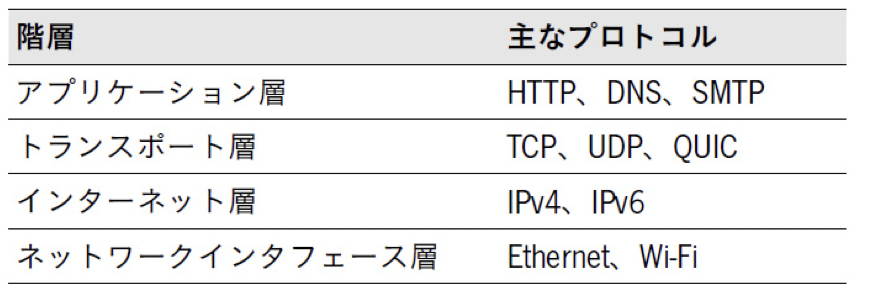Summary
This is from WEB+DB EXPRESS vol122. First, an overview of Internet technologies and various protocols.
Internet Technologies Overviews
First, let’s take a look at Internet technology, which is the base of Web technology. The Internet began with ARPNET, which is a system for communication via multiple computers, and research on ARPANET began in the late 1960s and was realized in the United States in the early 1970s. In the beginning, it was a fault-tolerant network.
The Internet Protocol Suite (Suite means a set of protocols) was originally developed for military purposes to build fault-tolerant networks, but it has been sublimated into a standard technology that is widely used around the world. The protocols used in the Internet Protocol Suite are divided into several layers, and the higher level protocols hide the lower level protocols to achieve communication. This is called encapsulation. This encapsulation ensures the modularity between each layer and enables the interconnection of various networks. An overview of the protocols is given below.

WEB+DBPRESS No.122より
The OSI (Open Systems Interconnection) was developed at the same time as these Internet protocols. Although this protocol was not adopted in the end (it was adopted by the Internet Protocol Suite), it is introduced together with the Internet Protocol Suite as the OSI reference model because it is a useful tool for discussing system configuration.

WEB+DB PRESS No122より
RFCs (Request for Comments) document the protocols used in this Internet protocol suite.
Let’s start with the network interface layer. The network interface protocol ensures communication between physical devices at the lowest layer, and has only the function of communicating data to directly connected devices (communication through multiple devices is provided by higher-level protocols). Specific protocols include Ethernet for wired LAN and Wifi for wireless LAN.
The next layer is the Internet layer. The Internet layer is a layer that provides communication via multiple devices, and even if a new communication method between devices is introduced in the future, it is abstracted by the network interface, so it can be introduced without affecting the protocols of the Internet layer. There are two protocols used in the Internet layer, IPv4 and IPv6. In IPv4, 32 bits of information are divided into 8 bits each, and the 8 bits range from 0-255, so the values in that range are lined up, for example, 192.168.0.1. For example, 192.168.0.1. IPv6, on the other hand, extends the range to 128 bits.
The transport layer not only connects multiple devices, but also provides functions that must be realized in a network, such as packet error handling and management of multiple connections, and there are two protocols, TCP and UDP.
There are two protocols, TCP and UDP, which provide functions such as retransmission of missing packets, guaranteeing the order of arriving packets, etc. TCP is a connection-based protocol, and it uses a three-way handshake to check the communication availability of both parties before starting communication. TCP is a connection-type protocol, and it uses a three-way handshake to check the availability of each other before starting communication, which increases the reliability of the connection. Multiple connections are also provided so that different devices can communicate with each other. For this reason, TCP communication uses a port number to distinguish between connections, and a number is reserved in advance for communication with commonly used applications, such as 80 in HTTP. Translated with www.DeepL.com/Translator (free version)
UDP is a protocol that focuses on high speed. Therefore, it does not wait for the other party’s response (connectionless communication). UDP is mainly used for streaming communications such as audio and video, where missing data does not cause major problems because it does not retransmit missing data.
QUIC is an upper layer protocol of TCP that is designed for high speed and high reliability; in TCP, encrypted communication is performed in a separate layer, but in QUIC, they are integrated. This QUIC is used in protocols such as http.
The application layer protocols determine how to use the network infrastructure consisting of the lower layer protocols described above.
HTTP (Hypertext Transfer Protocol) is a typical application layer protocol that is used by browsers to communicate with web servers. Originally, its main purpose was to transfer HTML data, but with the development of web technology, various functions have been added and upgraded.
DNS (Domain Name System) is a service that converts an IP address, which is a number, into a host name (e.g. www.example.com) for communication between multiple devices, and people use the host name to convert it into an IP address for actual communication. Since it is difficult to maintain a table of all host names and IP addresses in the DNS, the DNS functions as a distributed database in which each domain owner manages only its own table of host names in units of groups of host names called domains. DNS information is also managed by a neutral organization called a registrar.
SMTP (Simple Mail Transfer Protocol) is a protocol for sending e-mail, and POP3 and IMAP (Internet Message Accesss Protocol) are used for receiving e-mail.
SSL (Secure Socket Layer) and its successor, TLS (Transport Layer Security) are used as protocols to ensure security on the Internet. While TCP and UDP provide SSL/TLS as separate protocols, QUIC includes TLS.
In the next article, we will discuss HTTPS in more detail.



コメント